Cream soup
A cream soup is a soup prepared using cream, light cream, half and half, or milk as a key ingredient.[1] Sometimes the dairy product is added at the end of the cooking process, such as after a cream soup has been puréed.[2]
A cream soup will often have a soup base, prepared with ingredients such as onion, celery, garlic powder, celery salt, butter, bacon drippings, flour, salt, pepper, paprika, milk, light cream, and chicken stock or vegetable stock.[3] Various vegetables or meats are then added to the base. Sometimes, leftover vegetables and meats are used in cream soups.[4]
List of cream soups
A multitude of notable cream soups exist, including, but not limited to the following listed below.
| Image | Soup Name | Description |
|---|---|---|
 |
Bisque | Heavy cream soups traditionally prepared with shellfish, but can be made with any type of seafood or other base ingredients[5] |
 |
Bobó de camarão | A chowder-like Brazilian dish of shrimp in a purée of manioc (or cassava) meal with coconut milk and other ingredients.[6] |
 |
Chowder | Often prepared with milk or cream, fish chowder, corn chowder, and clam chowder are especially popular in the North American regions of New England and Atlantic Canada. |
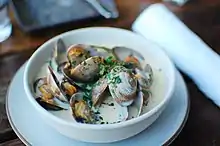 |
Clam chowder | Any of several chowder soups containing clams and broth, many regional variations exist, but the two most prevalent are New England or "white" clam chowder, a cream-based chowder, and Rhode Island/Manhattan "red" clam chowder, which is typically prepared without a cream base. |
 |
Corn chowder | Basic corn chowder ingredients comprise corn, onion, celery, milk or cream and butter. |
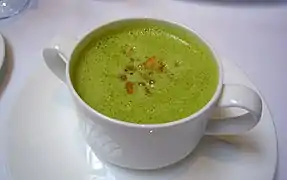 |
Cream of asparagus soup | Asparagus, a light chicken or vegetable stock and milk or cream are primary ingredients.[7] |
.jpg.webp) |
Cream of broccoli soup | Primary ingredients are broccoli, stock and milk or cream.[8][9][10] Mass-produced commercial varieties of cream of broccoli soup are produced by various food manufacturers, such as the Campbell Soup Company.[11][12] |
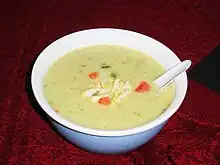 |
Cream of chicken soup | Mass-produced in a condensed soup form, various non-commercial and homemade variations also exist |
 |
Cream of mushroom soup | A simple soup where a basic roux is thinned with cream or milk and then mushrooms and/or mushroom broth are added. In America, the Campbell Soup Company began producing its well-known condensed "Cream of Mushroom Soup" in 1934.[13] |
.jpg.webp) |
Cream of spinach | With spinach as a main ingredient, additional ingredients can include onion, green onion, carrot, celery, tomatoes, potatoes, lemon juice, olive oil, seasonings, salt and pepper.[14][15] Spinach soup is typically served hot, but can also be served as a cold soup.[16][17] |
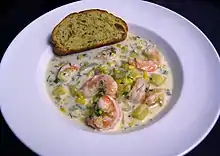 |
Cream of shrimp | Sometimes prepared as a cream soup, pictured is a shrimp chowder. |
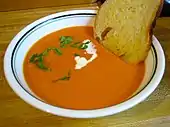 |
Cream of tomato | Cream of tomato soup is made with tomatoes as the primary ingredient and cream or milk as an ingredient.[18] It may be served hot or cold in a bowl, and may be made in a variety of ways.[19] |
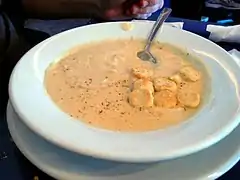 |
She-crab soup | A rich soup similar to a bisque, made of milk or heavy cream, crab or fish stock, Atlantic blue crab meat, and (traditionally) crab roe, a small amount of dry sherry added as it is plated. |
Additional cream soups include cream of cauliflower, cream of fennel, cream of potato, cream of corn, cream of walnut, cream of roasted pumpkin, cream of celery and cream-of-anything soup.[2]
Gallery
 Cream of clams soup
Cream of clams soup Cream of corn soup
Cream of corn soup Cream of fava beans soup
Cream of fava beans soup.jpg.webp) Cream of potato soup
Cream of potato soup Cream of roasted pumpkin soup
Cream of roasted pumpkin soup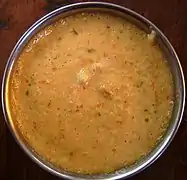 Cream of rocoto soup
Cream of rocoto soup Cream of walnut soup
Cream of walnut soup
See also
References
- De Gouy, L.P. (2018). "Chapter 6: Vegetable, Poultry, Nut, and Game". The Soup Book: Over 700 Recipes. Dover Publications. pp. 145–187+. ISBN 978-0-486-83478-8. Retrieved July 21, 2019.
- Lam, Francis (March 5, 2011). "How to make cream-of-anything soup". Salon. Retrieved July 21, 2019.
- Child, J. (2010). Julia's Kitchen Wisdom. Knopf Doubleday Publishing Group. pp. 8–13. ISBN 978-0-307-59353-5. Retrieved July 21, 2019.
- Goudiss, C.H.; Goudiss, A.M. (1918). Foods that Will Win the War: And how to Cook Them. World Syndicate Company. pp. 106–108. Retrieved July 21, 2019.
- Simmons, M.; Williams, C.; Kauck, J. (2005). Williams-Sonoma Mastering: Soups & Stews. Williams Sonoma mastering. Free Press. pp. 105–107. ISBN 978-0-7432-6736-6. Retrieved July 21, 2019.
- Danny Palmerlee (1 March 2007). South America on a Shoestring. Lonely Planet. p. 402. ISBN 978-1-74104-443-0.
- A Complete Course in Canning. 1906.
- De Gouy, Louis P. (1974). The Soup Book: Over 800 Recipes. New York: Dover. pp. 145–146. ISBN 978-0-4861-4449-8 – via Google Books.
- Hanson, BJ; Hanson, Jeanne (2008). The Everything Soup Cookbook. Avon: Adams Media. p. 85. ISBN 978-1-6055-0571-8 – via Google Books.
- Gisslen, Wayne; Griffin, Mary Ellen (2006). Professional Cooking for Canadian Chefs (6th ed.). Hoboken, NJ: John Wiley & Sons. p. 225. ISBN 978-0-4716-6377-5 – via Google Books.
- "Winning Recipe May Change President's Vote on Broccoli". Beaver County Times. October 30, 1991. p. C4. Retrieved September 8, 2014 – via Google News.
- "Campbell's Cooks Up Another Winner". Deseret News. Salt Lake City, UT. October 9, 1990. Retrieved September 8, 2014.
- Hoffman, S.; Wise, V. (2013). Bold: A Cookbook of Big Flavors. Workman Publishing Company. p. 63. ISBN 978-0-7611-3961-4. Retrieved July 21, 2019.
- "The Fountain on Locust's Cream of Spinach Soup". St. Louis Post-Dispatch. January 12, 2016. Retrieved March 20, 2017.
- "Savory Cream of Spinach Soup". Mother Nature Network. December 5, 2014. Retrieved March 20, 2017.
- Child, Julia (2012). Mastering the Art of French Cooking. Knopf Doubleday Publishing Group. p. pt58. ISBN 978-0-307-95818-1.
- Molokhovets, E.; Toomre, J. (1998). Classic Russian Cooking: Elena Molokhovets' a Gift to Young Housewives. Indiana-Michigan Series in Russian and East European Studies. Indiana University Press. p. 589. ISBN 978-0-253-21210-8.
- Harland, G.; Craxton, S.L. (2009). Tomato: A Guide to the Pleasures of Choosing, Growing, and Cooking. DK Publishing. p. 146. ISBN 978-0-7566-5720-8. Retrieved July 21, 2019.
- Herbig, Paul A. (1998). Handbook of Cross-Cultural Marketing. Binghamton, NY: International Business Press. p. 45. ISBN 978-0789001542.
Irish and Italians prefer creamy tomato soup, Germans want rice, and Colombians want spice.